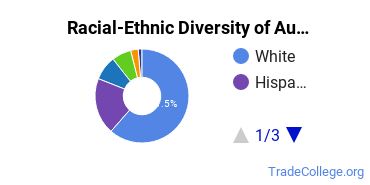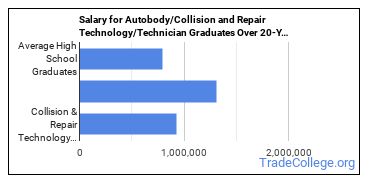Collision & Repair Technology
Featured schools near , edit
Types of Degrees Collision & Repair Technology Majors Are Getting
The following table lists how many autobody/collision & repair technology/technician graduations there were in 2021-2022 for each degree level.
| Education Level | Number of Grads |
|---|---|
| Undergraduate Certificate | 2,619 |
| Basic Certificate | 1,553 |
| Associate Degree | 552 |
| Bachelor’s Degree | 1 |
What Collision & Repair Technology Majors Need to Know
People with careers related to autobody/collision and repair technology/technician were asked what knowledge areas, skills, and abilities were important for their jobs. They weighted these areas on a scale of 1 to 5 with 5 being the highest.
Knowledge Areas for Autobody/Collision and Repair Technology/Technician Majors
This major prepares you for careers in which these knowledge areas are important:

- Customer and Personal Service - Knowledge of principles and processes for providing customer and personal services. This includes customer needs assessment, meeting quality standards for services, and evaluation of customer satisfaction.
- English Language - Knowledge of the structure and content of the English language including the meaning and spelling of words, rules of composition, and grammar.
- Mechanical - Knowledge of machines and tools, including their designs, uses, repair, and maintenance.
- Administration and Management - Knowledge of business and management principles involved in strategic planning, resource allocation, human resources modeling, leadership technique, production methods, and coordination of people and resources.
- Production and Processing - Knowledge of raw materials, production processes, quality control, costs, and other techniques for maximizing the effective manufacture and distribution of goods.
Skills for Autobody/Collision and Repair Technology/Technician Majors
The following list of skills has been highlighted as some of the most essential for careers related to autobody/collision and repair technology/technician:

- Speaking - Talking to others to convey information effectively.
- Critical Thinking - Using logic and reasoning to identify the strengths and weaknesses of alternative solutions, conclusions or approaches to problems.
- Active Listening - Giving full attention to what other people are saying, taking time to understand the points being made, asking questions as appropriate, and not interrupting at inappropriate times.
- Time Management - Managing one’s own time and the time of others.
- Judgment and Decision Making - Considering the relative costs and benefits of potential actions to choose the most appropriate one.
Abilities for Autobody/Collision and Repair Technology/Technician Majors
As a autobody/collision and repair technology/technician major, you will find yourself needing the following abilities:

- Near Vision - The ability to see details at close range (within a few feet of the observer).
- Oral Comprehension - The ability to listen to and understand information and ideas presented through spoken words and sentences.
- Oral Expression - The ability to communicate information and ideas in speaking so others will understand.
- Problem Sensitivity - The ability to tell when something is wrong or is likely to go wrong. It does not involve solving the problem, only recognizing there is a problem.
- Arm-Hand Steadiness - The ability to keep your hand and arm steady while moving your arm or while holding your arm and hand in one position.
What Can You Do With a Collision & Repair Technology Major?
People with a autobody/collision and repair technology/technician degree often go into the following careers:
| Job Title | Job Growth Rate | Median Salary |
|---|---|---|
| Automotive Body and Related Repairers | 8.5% | $42,730 |
| Automotive Glass Installers and Repairers | 6.6% | $34,170 |
| Painters, Transportation Equipment | 6.5% | $42,280 |
Who Is Getting an Associate’s Degree in Collision & Repair Technology?
Racial-Ethnic Diversity
At the countrywide level, the racial-ethnic distribution of autobody/collision and repair technology/technician majors is as follows:

| Race/Ethnicity | Number of Grads |
|---|---|
| Asian | 12 |
| Black or African American | 32 |
| Hispanic or Latino | 137 |
| White | 321 |
| International Students | 2 |
| Other Races/Ethnicities | 48 |
Geographic Diversity
Autobody/Collision and Repair Technology/Technician appeals to people across the globe. About 0.4% of those with this major are international students.
How Much Do Collision & Repair Technology Majors Make?
Salaries According to BLS
Average salaries range from $36,370 to $46,460 (25th to 75th percentile) for careers related to autobody/collision and repair technology/technician. This range includes all degree levels, so you may expect those with a more advanced degree to make more while those with less advanced degrees will typically make less.
To put that into context, according to BLS data from the first quarter of 2020, the typical high school graduate makes between $30,000 and $57,900 a year (25th through 75th percentile). The average person with a bachelor’s degree (any field) makes between $45,600 and $99,000. Advanced degree holders make the most with salaries between $55,600 and $125,400.
Amount of Education Required for Careers Related to Collision & Repair Technology
Some careers associated with autobody/collision and repair technology/technician require an advanced degree while some may not even require a bachelor’s. Whatever the case may be, pursuing more education usually means that more career options will be available to you.
Find out what the typical degree level is for autobody/collision and repair technology/technician careers below.

| Education Level | Percentage of Workers |
|---|---|
| Less than a High School Diploma | 10.5% |
| High School Diploma - or the equivalent (for example, GED) | 49.8% |
| Post-Secondary Certificate - awarded for training completed after high school (for example, in agriculture or natural resources, computer services, personal or culinary services, engineering technologies, healthcare, construction trades, mechanic and repair technologies, or precision production) | 28.3% |
| Some College Courses | 7.7% |
| Associate’s Degree (or other 2-year degree) | 3.8% |
| Bachelor’s Degree | 0.4% |
Online Collision & Repair Technology Programs
The following table lists the number of programs by degree level, along with how many schools offered online courses in the field.
| Degree Level | Colleges Offering Programs | Colleges Offering Online Classes |
|---|---|---|
| Certificate (Less Than 1 Year) | 0 | 0 |
| Certificate (1-2 years) | 262 | 0 |
| Certificate (2-4 Years) | 29 | 0 |
| Associate’s Degree | 159 | 1 |
| Bachelor’s Degree | 0 | 0 |
| Post-Baccalaureate | 0 | 0 |
| Master’s Degree | 0 | 0 |
| Post-Master’s | 0 | 0 |
| Doctor’s Degree (Research) | 0 | 0 |
| Doctor’s Degree (Professional Practice) | 0 | 0 |
| Doctor’s Degree (Other) | 0 | 0 |
Is a Degree in Collision & Repair Technology Worth It?
The median salary for a autobody/collision and repair technology/technician grad is $46,460 per year. This is based on the weighted average of the most common careers associated with the major.
This is 16% more than the average salary for an individual holding a high school degree. This adds up to a gain of about $131,200 after 20 years!

Explore Major by State
Alabama
California
District of Columbia
Idaho
Kansas
Maryland
Mississippi
Nevada
New York
Oklahoma
South Carolina
Utah
West Virginia
Alaska
Colorado
Florida
Illinois
Kentucky
Massachusetts
Missouri
New Hampshire
North Carolina
Oregon
South Dakota
Vermont
Wisconsin
Trades Related to Collision & Repair Technology
You may also be interested in one of the following majors related to autobody/collision and repair technology/technician.
References
*The racial-ethnic minorities count is calculated by taking the total number of students and subtracting white students, international students, and students whose race/ethnicity was unknown. This number is then divided by the total number of students at the school to obtain the racial-ethnic minorities percentage.
- College Factual
- College Scorecard
- National Center for Education Statistics
- O*NET Online
- U.S. Bureau of Labor Statistics
- Usual Weekly Earnings of Wage and Salary Workers First Quarter 2020
- Image Credit: By Airman 1st Class Nigel Sandridge under License
More about our data sources and methodologies.
Featured Schools
 Request Info
Request Info
|
Southern New Hampshire University You have goals. Southern New Hampshire University can help you get there. Whether you need a bachelor's degree to get into a career or want a master's degree to move up in your current career, SNHU has an online program for you. Find your degree from over 200 online programs. Learn More > |
